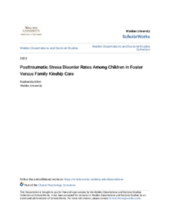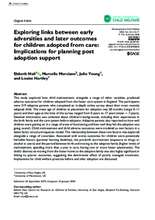Displaying 501 - 510 of 2214
This paper reports on an empirical study of child protection services in a local authority where rates of investigations and interventions rose to unprecedented levels during the course of a single year.
The purpose of this study was to address the gap in the literature on the full spectrum of posttraumatic stress disorder (PTSD) attributes and symptoms for children living in nonkinship foster homes versus kinship foster homes, as well as examine the benefits and limitations of children placed in kinship and nonkinship foster homes.
This article provides recommendations for adapting the pediatric medical home (PMH) model for health care needs of youth in foster care.
This study explored how child maltreatment, alongside a range of other variables, predicted adverse outcomes for children adopted from the foster care system in England.
A qualitative program evaluation was conducted, including focus groups with 36 parenting young women who had participated in Passport to Parenting (P2P) initiative services and interviews with 11 key staff of the three partnering agencies.
The current study provides a more nuanced account of foster youth with disabilities’ transitions into adulthood.
This article identifies the steps that can be taken to support women at risk of recurrently losing children to care.
This study examined the impact of health care education materials designed for foster youth, called ICare2CHECK. It was hypothesized that ICare2CHECK would increase nonurgent ambulatory health care use and decrease emergency/urgent care use.
This study used variations in the adoption and refund status of state-level Earned Income Tax Credit (EITC), a socioeconomic policy intended to reduce poverty, to examine their effect on foster care entry rates in the U.S.
This study aimed to explain the development of the educational gap between children in “out‐of‐home care” (CLA), children deemed in social need (CIN), and other pupils.


